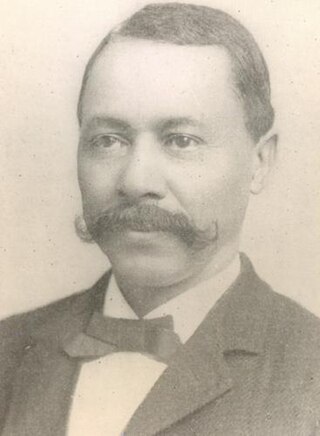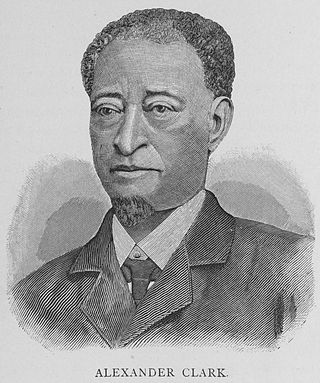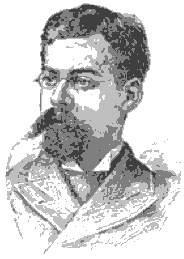
Cheyney University of Pennsylvania is a public historically black university in Cheyney, Pennsylvania. Founded in 1837 as the Institute for Colored Youth, it is the oldest of all historically black colleges and universities (HBCUs) in the United States. It is a member of the Pennsylvania State System of Higher Education and the Thurgood Marshall College Fund. The university offers bachelor's degrees and is accredited by the Middle States Commission on Higher Education.

Radnor Township, often called simply Radnor, is a first class township with home rule status in Delaware County, Pennsylvania, United States.

Bella Vista, Italian for "beautiful sight", is a neighborhood in the South Philadelphia section of Philadelphia, Pennsylvania, United States.

Ebenezer Don Carlos Bassett was United States Ambassador to Haiti from 1869 to 1877. He was the first African American diplomat and the fourth U.S. ambassador to Haiti since the two countries established relations in 1862. His mother was Pequot. From 1857 to 1869 he was the principal of the Institute for Colored Youth in Philadelphia.
Richard Humphreys was an American silversmith and philanthropist who founded a school for African Americans in Philadelphia. Originally called the African Institute, it was renamed the Institute for Colored Youth and eventually became Cheyney University of Pennsylvania, the oldest historically black university in the United States.

Eden Cemetery is a historic African-American cemetery located in Collingdale, Pennsylvania. It was established June 20, 1902, and is the oldest existing black owned cemetery in the United States. The cemetery covers about 53 acres and contains approximately 93,000 burials.

Alexander G. Clark was an African-American businessman and activist who served as United States Ambassador to Liberia in 1890–1891, where he died in office. In 1867 Clark sued to gain admission for his daughter to attend a local public school in Muscatine, Iowa. The case of Clark v. Board of School Directors achieved a constitutional ruling for integration from the Iowa Supreme Court in 1868, 86 years before the United States Supreme Court decision of Brown v. Board of Education (1954). He was a prominent leader in winning a state constitutional amendment that gained the right for African Americans in Iowa to vote (1868). Active in church, freemasonry, and the Republican Party, he became known for his speaking skills and was nicknamed "the Colored Orator of the West." He earned a law degree and became co-owner and editor of The Conservator in Chicago. His body was returned from Liberia in 1892 and buried in Muscatine, where his house has been preserved.

David Bustill Bowser was a 19th-century African-American ornamental artist, portraitist, and social activist. He designed battle flags for eleven African-American regiments during the American Civil War and painted portraits of prominent Americans, including U.S. President Abraham Lincoln and abolitionist John Brown. Politically active throughout much of his adult life, he was a contributor to the Undergrounds Railroad and also helped to secure the post-war passage of key civil rights legislation in Pennsylvania.

Gertrude Emily Hicks Bustill Mossell was an American journalist, author, teacher, and activist. She served as the women's editor of The New York Age from 1885 to 1889, and of the Indianapolis World from 1891 to 1892. She strongly supported the development of black newspapers and advocated for more women to enter journalism.

Sarah Mapps Douglass was an American educator, abolitionist, writer, and public lecturer. Her painted images on her written letters may be the first or earliest surviving examples of signed paintings by an African American woman. These paintings are contained within the Cassey Dickerson Album, a rare collection of 19th-century friendship letters between a group of women.

Leslie Pinckney Hill was an American educator, writer, and community leader. From 1913 to 1951, he served as principal of the Institute for Colored Youth in Philadelphia and oversaw the institution's move to Cheyney, Pennsylvania, and its establishment as Cheyney State Teachers College. He also served as the college's first president.

The history of African Americans or Black Philadelphians in the city of Philadelphia, Pennsylvania has been documented in various sources. People of African descent are currently the largest ethnic group in Philadelphia. Estimates in 2010 by the U.S. Census Bureau documented the total number of people living in Philadelphia who identified as Black or African American at 644,287, or 42.2% of the city's total population.

Jacob C. White Jr. was an American educator, intellectual, and civil rights activist. Born to a successful and influential businessman, White received the finest education afforded to African-Americans of the time and became intertwined in the dealings of Philadelphia's most prominent black leaders. The first black man in the city to be appointed as a school principal at Roberts Vaux Consolidated School. During his tenure between 1864 and 1896, White reformed the institute and became the leading figure in the field of urban education in Philadelphia. Alongside his academic endeavors, White was significant in the sports field: he helped establish the Philadelphia Pythians, an early black baseball club. Following the shooting of his friend and fellow activist Octavius Catto in 1871, White became the top civil rights activist in the city, and remained active in the community until his death in 1902.
Cyrus Bustill was an African American brewer and baker, abolitionist and community leader.
Robert Douglass Jr. was an African-American artist and leading activist from Philadelphia.

John Stephens Durham (1861–1919) was a teacher, journalist, author, attorney, civil engineer, and diplomat who served as United States Minister Resident to Haiti. He was African-American. He also served in Cuba where he established a law practice and had a sugar plantation.
Grace A. Mapps was an American educator, administrator and poet, who may have been the first African-American woman to graduate with a four-year college degree. Mapps graduated from New-York Central College at McGrawville in 1852, but the type of degree she received is not recorded. As such, Mary Jane Patterson is widely regarded as the first African American woman to graduate with a four-year bachelor's degree. Understandings of Mapps' achievements are also complicated by regular confusion with relatives Sarah Mapps Douglass and Grace Douglass, both of whom were prominent activists and educators.
Benjamin Banneker Institute was a literary society for African Americans established in Philadelphia in 1854. Members lectured and debated on various subjects. It was named for Benjamin Banneker.
Joseph Cassey was a French West Indies-born American businessman, real estate investor, abolitionist, and activist. He prospered as a barber, and as well as a wig maker, perfumer, and money-lender. He lived in the historic Cassey House in Society Hill, and was active in the African American elite community in Philadelphia.



















